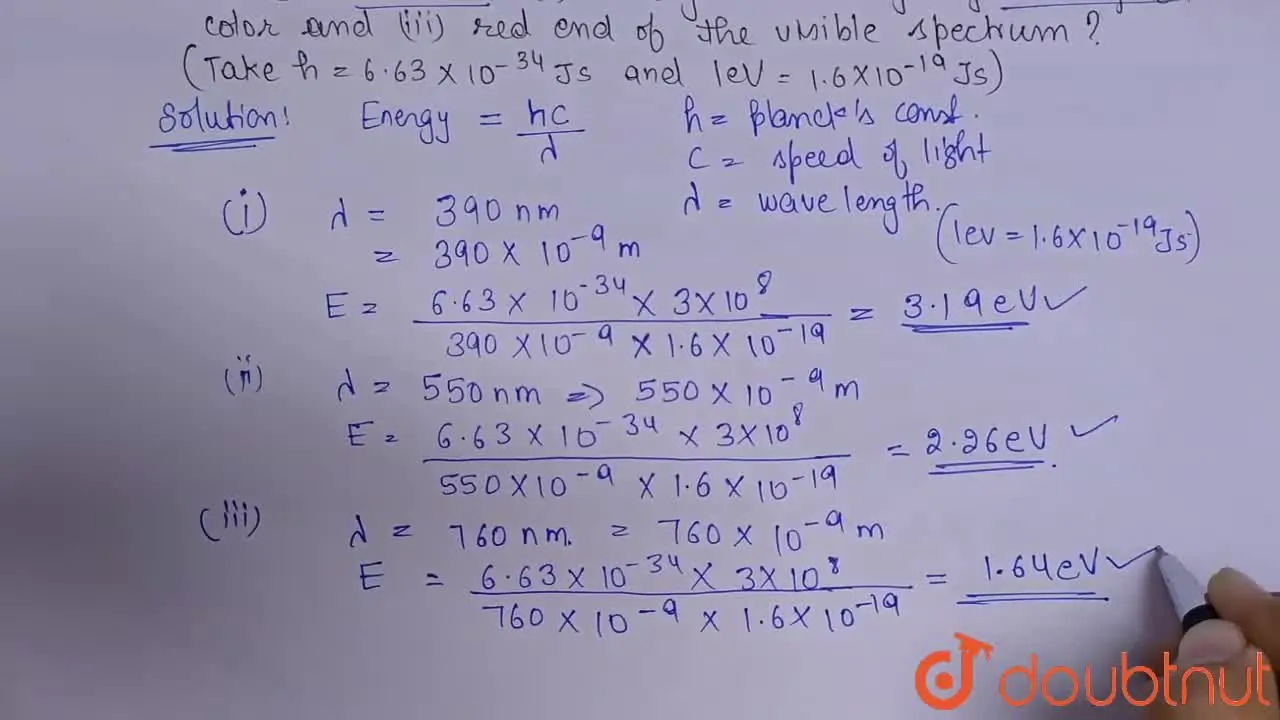The wavelength of light in the visible region is about 390nm for violet color, about 550nm (average wavelength) for yellow green colour and about 760nm for red color. What are the energies of photon in eV at the (i) violet end (ii) average wavelength yellow-green color and (iii) red end of the visible spectrum? (Take h=6.63×10−34Jsand1eV=1.6×10−19Js)
(a) Energy of the incident photon, E = hν = (hc)/λ
E=(6.63×10–34Js)(3×108m/s)/λ
=1.989×1025Jmλ
(i)For violet light, λ1=390nm (lower wavelength end )
Incident photon energy , E1=1.989×10−25Jm390×10−9m
=5.10×10–19J
=5.10×10–19J1.6×10−19J/eV
=3.19 eV
(ii)For yellow-green light, λ2=550nm (average wavelength )
Incident photon energy , E2=1.989×10−25Jm550×10−9m
=3.62×10−19J=2.26eV
(iii) For red light, λ3 = 760 nm (higher wavelength end)
Incident photon energy, E3=1.989×10−25Jm760×10−9m
=2.62×10−19J=1.64eV
(b) For a photoelectric device to operate, we require incident light energy E to be equal to or greater than the work function ϕ0 of the material. Thus, the photoelectric device will operate with violet light (with E = 3.19 eV) photosensitive material Na (with ϕ0 = 2.75 eV), K (with ϕ0 = 2.30 eV) and Cs (with ϕ0 = 2.14 eV). It will also operate with yellow-green light (with E = 2.26 eV) for Cs (with ϕ0 = 2.14 eV) only. However, it will not operate with red light (with E = 1.64 eV) for any of these photosensitive materials.
Related Playlists
Similar Questions
The wavelength of light in the visible region is about 390 nm for violet colour and about 760 nm for red colour. The energy of photon in eV at violet end is
View SolutionThe de Broglie wavelength of an electron with kinetic energy 120 e V is (Given h=6.63×10−34Js,me=9×10−31kg,1eV=1.6×10−19J)
View SolutionWhat is the (a) momentum (b) speed and (c) de-Broglie wavelength of an electron with kinetic energy of 120 eV. Given h=6.6×10−34Js,me=9×10−31kg,1eV=1.6×10−19J.
View Solutionin the question number 63, the frequency of emitted photon due to the given transition is (h=6.64×10−34Js,1eV=1.6×10−19J)
View SolutionAn electron and a photon each have a wavelength of 2.00nm. Find (i) their momenta (ii) the energy of the photon and (iii) the kinetic energy of electron. h=6.63×10−34Js
View SolutionAn electron and a photon each has a wavelength of 1.0nm. Find (a) their momenta, (b) the energy of the photon , and © the kinetic energy electron.
Take h=6.63×10−34Js.View Solutionthe wavelength range of the visible spectrum extends from violet ( 400 nm) to red ( 750 nm). Express these wavelengths in frequencies (Hz) . (1nm =10−9m)
View Solutionthe wavelegth range of the visible spectrum extends from violet ( 400 nm) to red ( 750 nm). Express these wavelengths in frequencies (Hz) . (1nm =10−9m)
View SolutionGiven the visible green light has a wavelength of 510 nm then corresponding frequency and wave number are respectively (C=3×108ms−1) :
View SolutionIf de Broglie wavelength of an electron is 0.5467 Å,
find the kinetic energy of electron in eV. Given h=6.6×10−34 Js ,
e=1.6×10−19 C, me=9.11×10−31 kg.View Solution


